Uncategorized
Crypto Daybook Americas: Bitcoin Defends $100K as MicroStrategy Votes on Share Increase

By Omkar Godbole (All times ET unless indicated otherwise)
Bitcoin held above $100,000, with VET, ENA, LINK and LDO posting notable gains a day after President Donald Trump bypassed mentioning crypto or a strategic bitcoin reserve in his inauguration speech.
Signals from the bitcoin options market indicate heightened expectations for short-term price turbulence alongside signs of growing risk aversion among traders since Trump’s swearing in, according to Griffin Ardern, head of options trading and research at crypto financial platform BloFin.
That could be due to several reasons, including MicroStrategy’s impending shareholder vote today on expanding its authorized shares to support its bitcoin buying strategy. In addition, the Bank of Japan (BOJ) is expected to increase rates on Friday, which may strengthen the yen. The late July BOJ rate hike torched the currency’s rally, destabilizing risk assets, including cryptocurrencies.
There’s also uncertainty stemming from Trump’s plans to impose tariffs of up to 25% on Canada and Mexico and the looming debt ceiling although, historically, the latter has not had a significant bearish impact on risk assets.
«Markets received a stark reminder of life under President Trump, with more volatility-inducing rhetoric,» QCP Capital said,.
Still, observers remain optimistic.
“Despite a generally disappointing first day for cryptocurrencies under the new administration, Bitcoin managed to remain firmly above $101K, sidestepping the feared ‘sell-the-news’ effect,” Valentin Fournier, an analyst at BRN, noted. Fournier added that while regulatory progress and adjustments to national reserves may take time, conditions are expected to improve in the coming weeks.
The debut of the TRUMP memecoin over the weekend marked «a fundamental shift in the American digital asset landscape, ultimately attracting new buyers, particularly into BTC and SOL,» according to Laurent Benayoun, CEO of Acheron Trading.
«This phenomenon can be seen as a dual narrative: a significant value creation in TRUMP, initially driven by intra-market rotation, which later sparked fresh capital inflows as fundamental investors recognized the broader positive catalysts for digital assets,» Benayoun said. Stay alert!
What to Watch
Crypto
Jan. 21: MicroStrategy (MSTR) shareholders vote on increasing the authorized share capital to help fund bitcoin purchases.
Jan. 23: First deadline for SEC decision on NYSE Arca’s proposal to list and trade shares of Grayscale Solana Trust (GSOL), a closed-end trust, as an ETF.
Jan. 25: First deadline for SEC decisions on proposals for four spot solana ETFs: Bitwise Solana ETF, Canary Solana ETF, 21Shares Core Solana ETF and VanEck Solana Trust, which are all sponsored by Cboe BZX Exchange.
Jan. 29: Ice Open Network (ION) mainnet launch.
Feb. 4: MicroStrategy Inc. (MSTR) reports Q4 2024 earnings.
Feb. 4: Pepecoin (PEPE) halving. At block 400,000, the reward will drop to 31,250 pepecoin.
Feb. 5, 3:00 p.m.: Boba Network’s Holocene hard fork network upgrade for its Ethereum-based L2 mainnet.
Feb. 12: Hut 8 Corp. (HUT) reports Q4 2024 earnings.
Feb. 15: Qtum (QTUM) hard fork network upgrade is scheduled to take place at block 4,590,000.
Feb. 20: Coinbase Global (COIN) reports Q4 2024 earnings.
Macro
Jan. 21, 8:00 a.m.: The U.S. Treasury will start taking «extraordinary measures» to stop the government from breaching the $36.1 trillion debt limit.
Jan. 21, 8:30 a.m.: Statistics Canada releases December’s Consumer Price Index.
Core Inflation Rate MoM Prev. -0.1%.
Core Inflation Report YoY Prev. 1.6%.
Inflation Rate MoM Est. -0.7% vs. Prev. 0%.
Inflation Rate YoY Est. 1.7% vs. Prev. 1.9%.
Jan. 22, 8:30 a.m.: Statistics Canada releases December’s Industrial Product Price Index.
PPI MoM Est. 0.8% vs. Prev. 0.6%.
PPI YoY Prev. 2.2%.
Jan. 22, 10:00 a.m.: The Conference Board releases December’s Leading Economic Index (LEI) report for the U.S.
MoM Est. -0.1% vs. Prev. 0.3%.
Token Events
Governance votes & calls
ApeChain is voting on a revamped governance process for 75% of the on-chain treasury to be directed to the DAO treasury contract and the remaining 25% to the Ape Foundation for administrative and support purposes. Voting began Jan. 17 and will last for 13 days.
CoW DAO is discussing the potential allocation of 80 million COW to empower the core treasury team for further liquidity provisioning, economic opportunities, and the development of the DAO’s product roadmap from 2025 to 2028.
Jan. 22: Mantle (MNT) will host a livestream with updates on its 2025 roadmap. at 8 a.m.
Unlocks
Jan. 21: Fasttoken (FTN) to unlock 4.6% of circulating supply worth $76 million.
Jan. 31: Jupiter (JUP) to unlock 41.5% of circulating supply worth $626 million.
Token Launches
Jan. 21: Bybit is listing Solayer (LAYER).
Jan. 22: Jambo (J) is listing on OKX, Bitfinex and Bybit.
Conferences:
Day 9 of 12: Swiss WEB3FEST Winter Edition 2025 (Zug, Zurich, St. Moritz, Davos)
Day 2 of 5: World Economic Forum Annual Meeting (Davos-Klosters, Switzerland)
Jan. 21: Frankfurt Tokenization Conference 2025
Jan. 24-25: Adopting Bitcoin (Cape Town, South Africa)
Jan. 25-26: Catstanbul 2025 (Istanbul). The first community conference for Jupiter, a decentralized exchange (DEX) aggregator built on Solana.
Jan. 30, 12:30 p.m. to 5:00 p.m.: International DeFi Day 2025 (online)
Jan 30-31: Plan B Forum (San Salvador, El Salvador)
Jan. 30 to Feb. 4: The Satoshi Roundtable (Dubai)
Feb. 3: Digital Assets Forum (London)
Feb. 5-6: The 14th Global Blockchain Congress (Dubai)
Feb. 7: Solana APEX (Mexico City)
Feb. 13-14: The 4th Edition of NFT Paris.
Feb. 18-20: Consensus Hong Kong
Feb. 23 to March 2: ETHDenver 2025 (Denver, Colorado)
Token Talk
By Shaurya Malwa
Donald and Melania Trump’s official memecoins have inspired wannabe token creators to issue tokens based on other family members. One such token themed after son Barron Trump just rug pulled for millions of dollars.
A spoof X account impersonating Barron promoted a BARRON token, which quickly gained traction reaching a peak market cap of $87 million.
Initially, a significant amount of liquidity was added to make the token appear legitimate and encourage trading. However, it seems the token was designed to deceive from the start. Once the token reached a high buy volume, all liquidity was removed from the token pools causing the price to crash.
On-chain watchers estimated at least $1 million worth of Solana’s SOL tokens were extracted in the rug pull, based on initial buying and final selling transactions.
Even some industry observers were take in.
Derivatives Positioning
Open interest in TRUMP perpetual futures has increased 8%, suggesting the price drop is at least partly led by fresh shorts. Opposite is the case for AAVE as prices have risen alongside an uptick in open interest.
Other than AAVE, most major coins, including BTC and ETH, have seen negative open interest-adjusted CVD, a sign of net selling pressure.
BTC and ETH calls remain pricier than puts, but the call bias is weaker than a day ago.
Top block trades for the day include BTC bull call spreads and some outright longs in ETH calls, according to data source Amberdata, Deribit and Paradigm.
Market Movements
BTC is down 0.3% from 4 p.m. ET Monday at $103,280.72 (24hrs: -4.66%)
ETH is down 0.43% at $3,307.05 (24hrs: -1.97%)
CoinDesk 20 is down 1.27% at 3,960.57 (24hrs: -5.14%)
Ether staking yield is up 27 bps at 3.58%
BTC funding rate is at -0.0026% (-2.9% annualized) on OKX
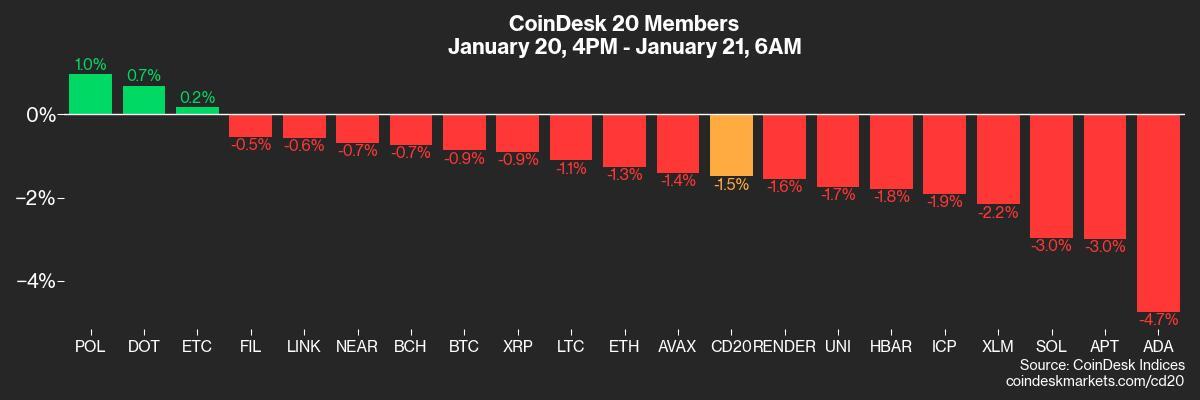
DXY is down 0.56% at 108.74
Gold is up 0.36% at $2,718.39/oz
Silver is unchanged at $30.48/oz
Nikkei 225 closed +0.32% to 39,027.98
Hang Seng closed +0.91% to 20,106.55
FTSE is unchanged at 8,521.58
Euro Stoxx 50 is unchanged at 5,160.68
DJIA closed on Friday +0.78% to 43,487.83
S&P 500 closed +1% to 5,996.66
Nasdaq closed +1.51% to 19,630.20
S&P/TSX Composite Index closed on Monday +0.41% to 25,171.58
S&P 40 Latin America closed +1.23% to 2,258.33
U.S. 10-year Treasury is down 4 bps at 4.59%
E-mini S&P 500 futures are up 0.44% at 6,060.00
E-mini Nasdaq-100 futures are up 0.48% at 21,698.75
E-mini Dow Jones Industrial Average Index futures are up 0.33% at 43,841.00
Bitcoin Stats:
BTC Dominance: 58.70
Ethereum to bitcoin ratio: 0.03193
Hashrate (seven-day moving average): 786 EH/s
Hashprice (spot): $60.7
Total Fees: 12.37 BTC/ $1.3M
CME Futures Open Interest: 188,825 BTC
BTC priced in gold: 37.8 oz
BTC vs gold market cap: 10.74%
Technical Analysis
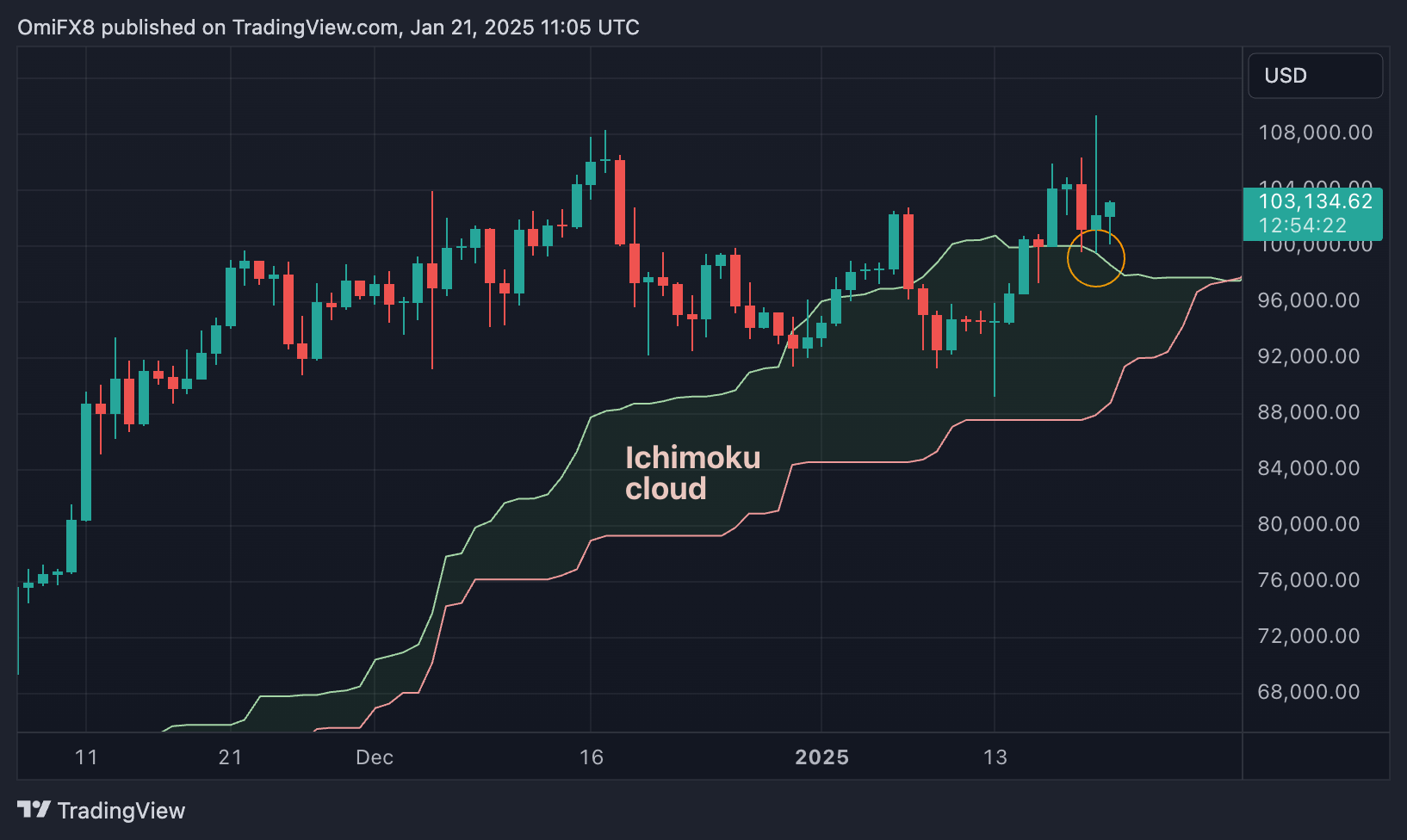
BTC remains in bullish territory above the Ichimoku cloud despite Trump failing to mention crypto or strategic BTC reserve Monday.
The resilience may entice more buyers to the market, potentially leading to record highs.
Crypto Equities
Galaxy Digital Holdings (GLXY): closed on Monday at C$31.15 (+4.04%).
MicroStrategy (MSTR): closed on Friday at $396.50 (+8.04%), down 2.22% at $387.70 in pre-market.
Coinbase Global (COIN): closed at $295.48 (+4.92%), down 0.65% at $293.55 in pre-market.
MARA Holdings (MARA): closed at $19.91 (+8.8%), down 0.5% at $19.81 in pre-market.
Riot Platforms (RIOT): closed at $13.38 (0.67%), down 0.3% at $13.35 in pre-market.
Core Scientific (CORZ): closed at $15 (+2.53%), up 0.47% at $15.07 in pre-market.
CleanSpark (CLSK): closed at $11.87 (+6.17%), up 0.51% at $11.93 in pre-market.
CoinShares Valkyrie Bitcoin Miners ETF (WGMI): closed at $25.37 (+3.13%).
Semler Scientific (SMLR): closed at $64.68 (+11.06%), down 1.52% at $63.70 in pre-market.
Exodus Movement (EXOD): closed at $38.51 (+1.69%), up 8.47% at $41.77 in pre-market.
ETF Flows
U.S. exchanges were closed on Jan. 20 in observance of Dr. Martin Luther King, Jr. Day.
The ETF data below is from Jan. 17 and remains unchanged.
Spot BTC ETFs:
Daily net flow: $1072.8 million
Cumulative net flows: $38.18 billion
Total BTC holdings ~ 1.11 million.
Spot ETH ETFs
Daily net flow: $23.9 million
Cumulative net flows: $2.66 billion
Total ETH holdings ~ 3.67 million.
Source: Farside Investors
Overnight Flows
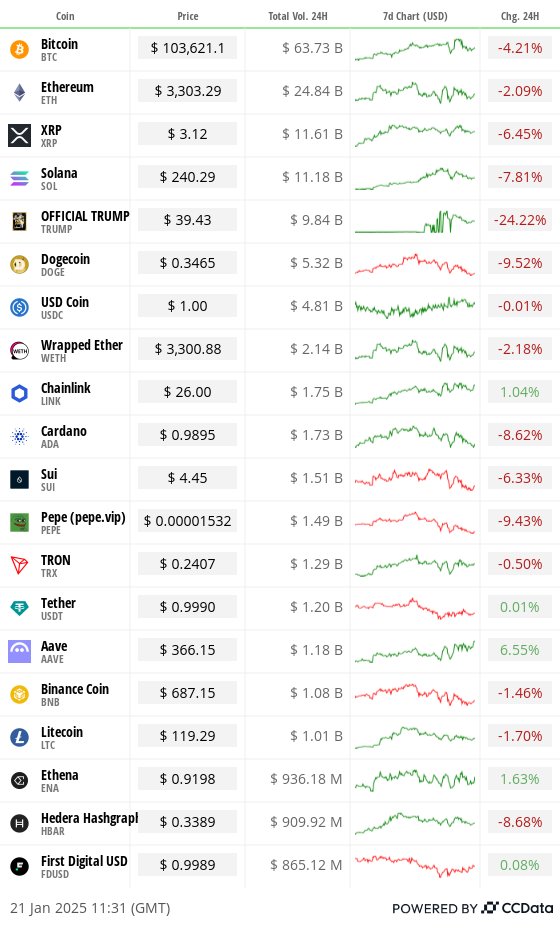
Chart of the Day
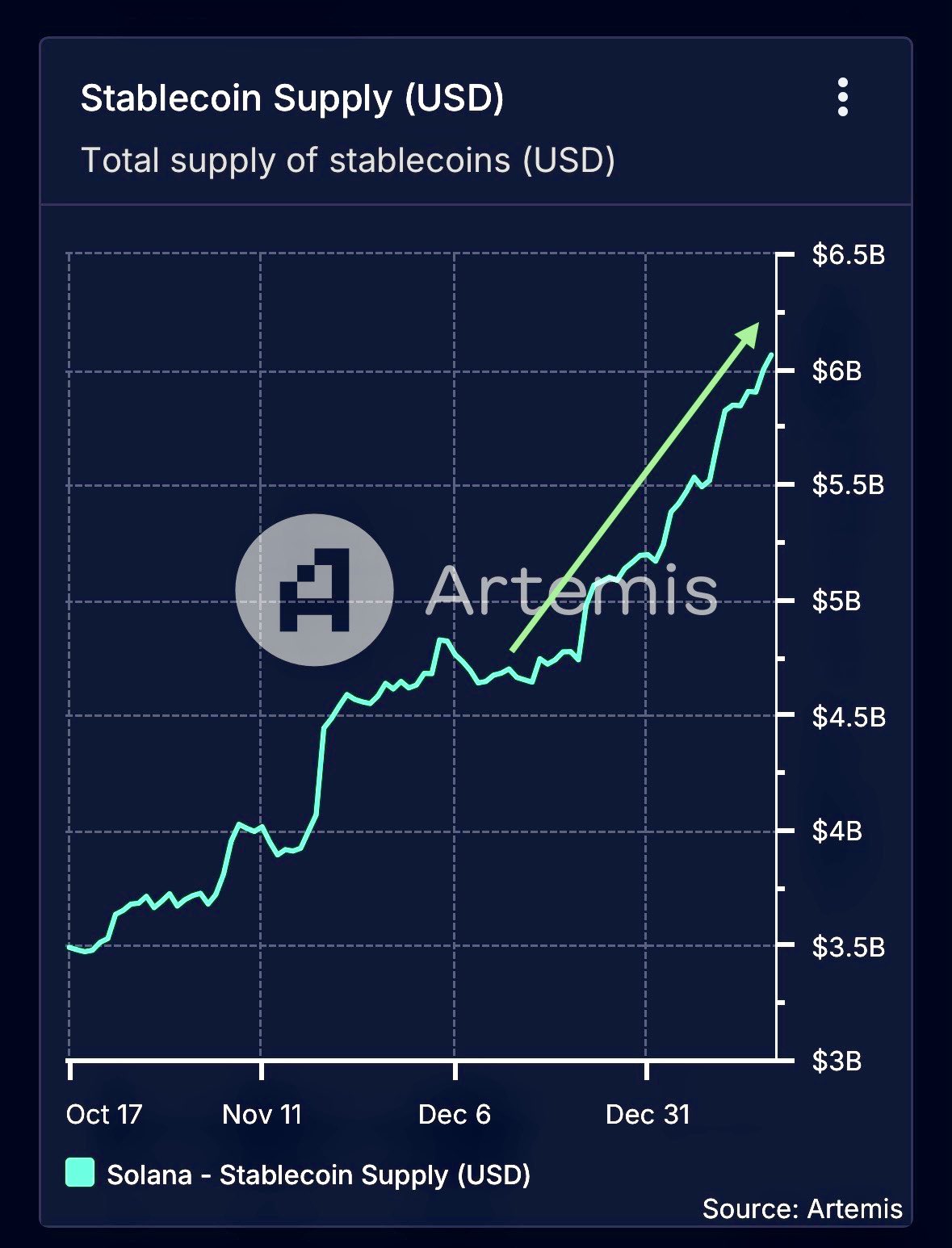
The supply of stablecoins on the Solana blockchain has nearly doubled since October.
Most of that is in USDC, the world’s second-largest dollar-pegged stablecoin.
While You Were Sleeping
U.S. to Hit Debt Ceiling on Tuesday. Will Bitcoin Soar or Suffer? (CoinDesk): The U.S. Treasury begins extraordinary measures to avoid breaching the $36.1 trillion debt limit. Historically, drawdowns in the Treasury General Account (TGA), the government’s cash reserve, have coincided with bitcoin price increases.
TRUMP, MELANIA Tokens Plunge 50% as Trump Inauguration Fails to Buoy Bitcoin (CoinDesk): Memecoins TRUMP and MELANIA fell sharply post-inauguration despite trading volumes exceeding many major tokens. QCP Capital speculates that TRUMP’s launch on Solana highlights the chain, potentially aiding U.S. SOL ETF prospects.
World Liberty Financial Buys $112.8 Million in Crypto on Trump’s First Day in Office (The Block): On Monday, World Liberty Financial, a Trump-linked crypto project, commemorated his inauguration by spending a total of $112.8M on ETH, wBTC, AAVE, LINK, TRX and ENA.
Trump’s Plans for Canada, Mexico Tariffs Send Dollar Higher (The Wall Street Journal): The U.S. dollar rose against the Canadian dollar and Mexican peso after Trump’s proposed tariffs. Asian markets showed mixed movements, while oil prices fell as Trump pledged expanded U.S. production.
ECB’s Kazimir Sees Three to Four More Cuts Starting Next Week (Bloomberg): Peter Kazimir, an ECB Governing Council member, expects a rate cut next week and possibly three more. He warns of risks from U.S. trade policies and inflationary pressures from import prices.
China Stocks, Yuan Cautiously Firm After Trump Delays Tariffs (Reuters): Chinese stocks and the yuan rose cautiously after Trump avoided imposing immediate tariffs, offering short-term relief. China is focusing on technological innovation and stimulating consumer spending to boost growth.
In the Ether
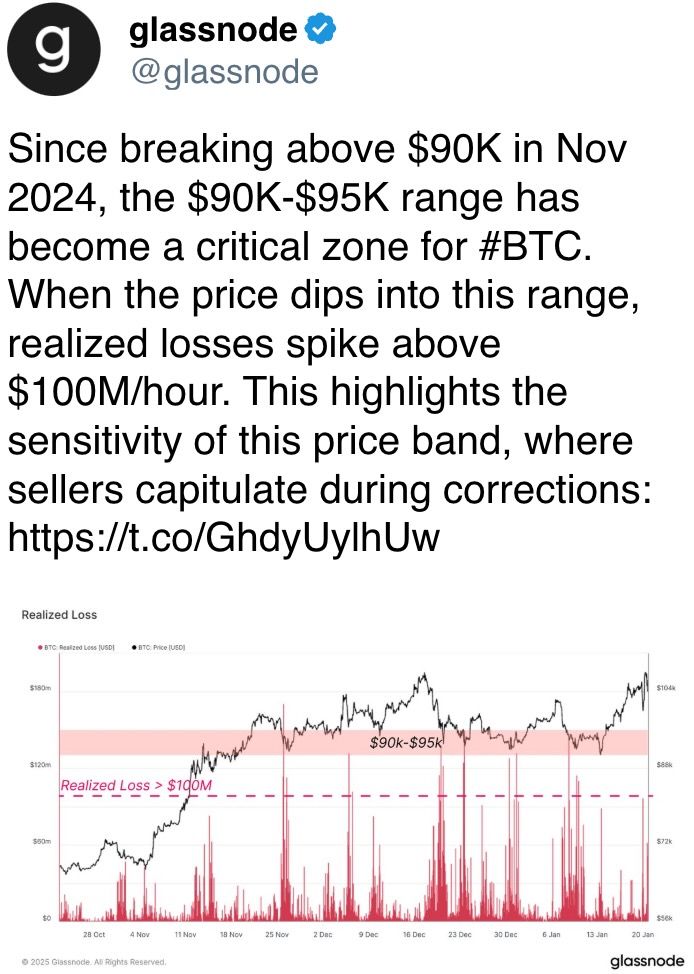
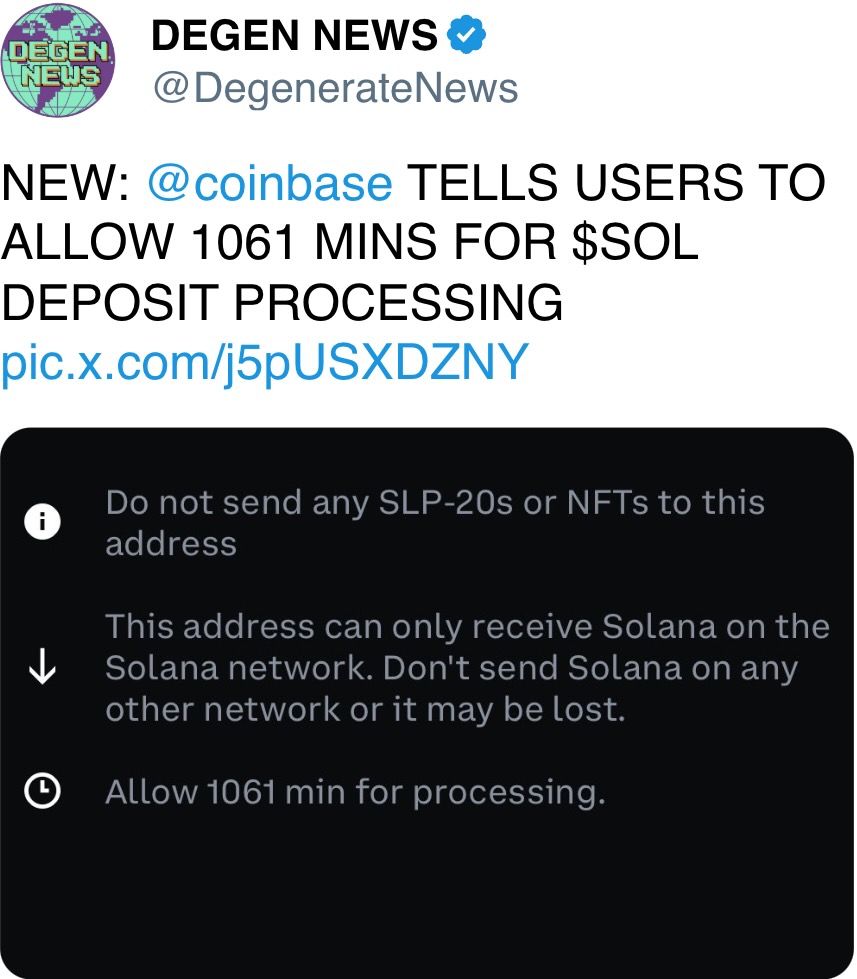
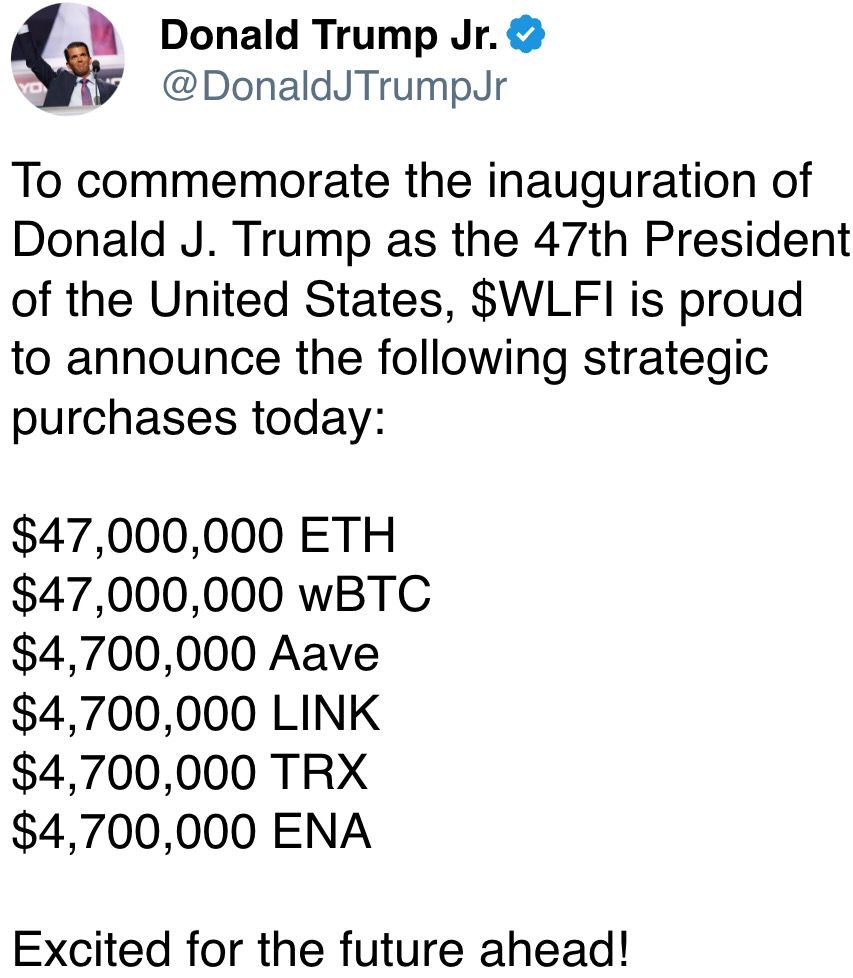
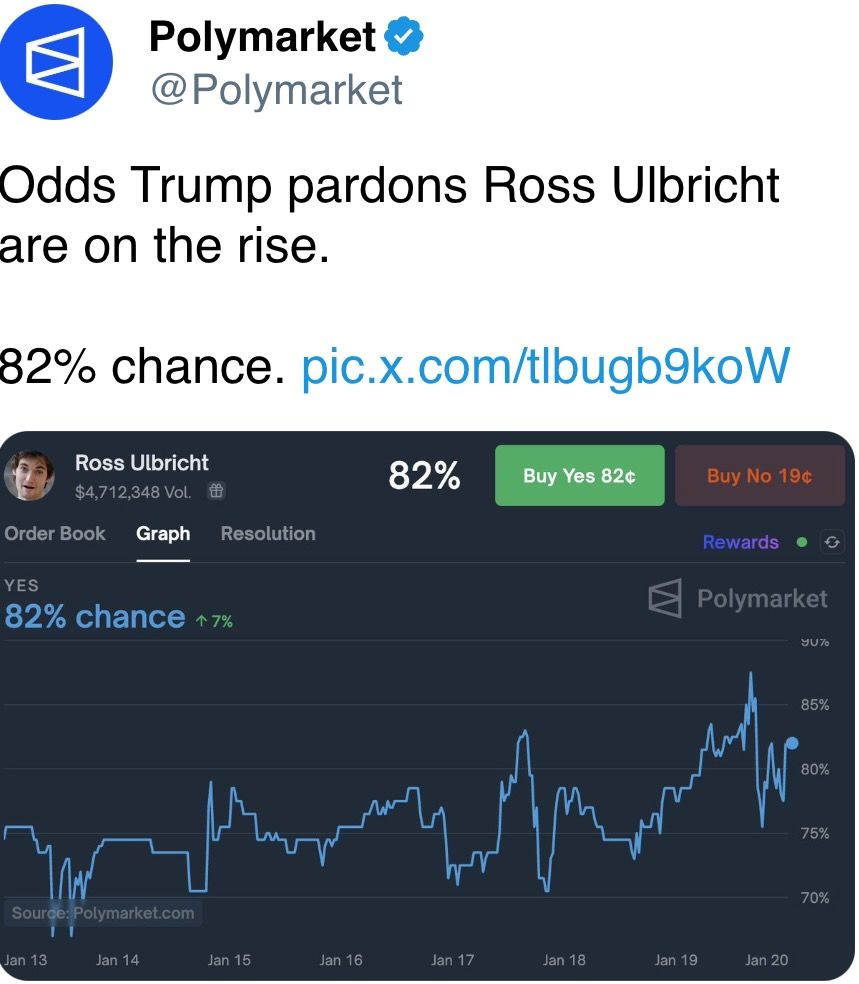
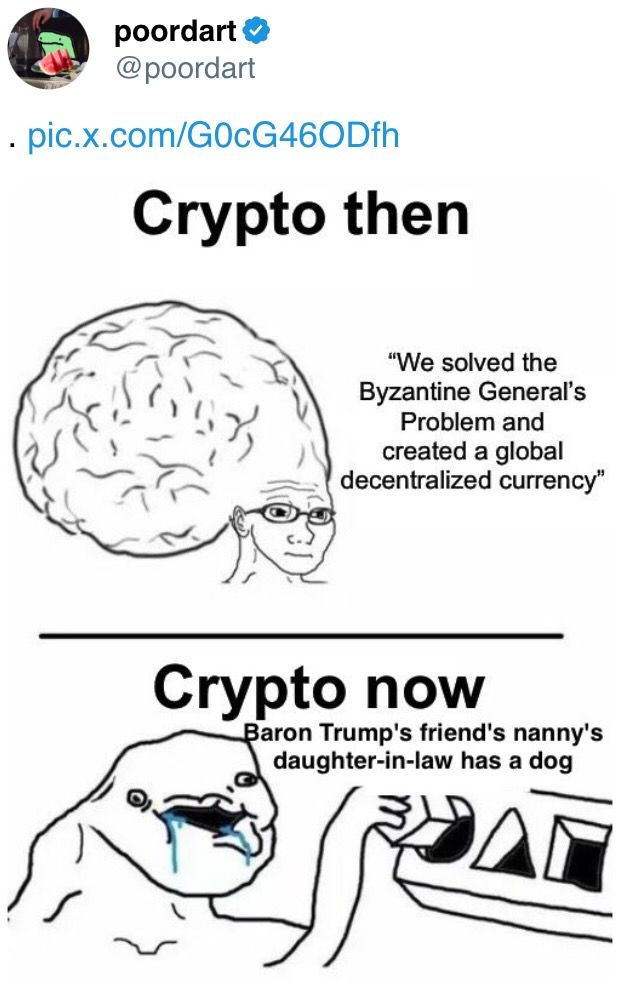

Business
AAVE Sees 64% Flash Crash as DeFi Protocol Endures ‘Largest Stress Test’

The native token of Aave (AAVE), the largest decentralized crypto lending protocol, was caught in the middle of Friday’s crypto flash crash while the protocol proved resilient in a historic liquidation cascade.
The token, trading at around $270 earlier in Friday, nosedived as much as 64% later in the session to touch $100, the lowest level in 14 months. It then staged a rapid rebound to near $240, still down 10% over the past 24 hours.
Stani Kulechov, founder of Aave, described Friday’s event as the «largest stress test» ever for the protocol and its $75 billion lending infrastructure.
The platform enables investors to lend and borrow digital assets without conventional intermediaries, using innovative mechanisms such as flash loans. Despite the extreme volatility, Aave’s performance underscores the evolving maturity and resilience of DeFi markets.
«The protocol operated flawlessly, automatically liquidating a record $180M worth of collateral in just one hour, without any human intervention,» Kulechov said in a Friday X post. «Once again, Aave has proven its resilience.»
Key price action:
- AAVE sustained a dramatic flash crash on Friday, declining 64% from $278.27 to $100.18 before recuperating to $240.09.
- The DeFi protocol demonstrated remarkable resilience with its native token’s 140% recovery from the intraday lows, underpinned by substantial trading volume of 570,838 units.
- Following the volatility, AAVE entered consolidation territory within a narrow $237.71-$242.80 range as markets digested the dramatic price action.
Technical Indicators Summary
- Price range of $179.12 representing 64% volatility during the 24-hour period.
- Volume surged to 570,838 units, substantially exceeding the 175,000 average.
- Near-term resistance identified at $242.80 capping rebound during consolidation phase.
Disclaimer: Parts of this article were generated with the assistance from AI tools and reviewed by our editorial team to ensure accuracy and adherence to our standards. For more information, see CoinDesk’s full AI Policy.
Business
Blockchain Will Drive the Agent-to-Agent AI Marketplace Boom

AI agents, software systems that use AI to pursue goals and complete tasks on behalf of users, are proliferating. Think of them as digital assistants that can make decisions and take actions towards goals you set without needing step-by-step instructions — from GPT-powered calendar managers to trading bots, the number of use cases is expanding rapidly. As their role expands across the economy, we have to build the right infrastructure that will allow these agents to communicate, collaborate and trade with one another in an open marketplace.
Big tech players like Google and AWS are building early marketplaces and commerce protocols, but that raises the question: will they aim to extract massive rents through walled gardens once more? Agents’ capabilities are clearly rising, almost daily, with the arrival of new models and architectures. What’s at risk is whether these agents will be truly autonomous.
Autonomous agents are valuable because they unlock a novel user experience: a shift from software as passive or reactive tools to active and even proactive partners. Instead of waiting for instructions, they can anticipate needs, adapt to changing conditions, and coordinate with other systems in real time, without the user’s constant input or presence. This autonomy in decision-making makes them uniquely suited for a world where speed and complexity outpace human decision-making.
Naturally, some worry about what greater decision-making autonomy means for work and accountability — but I see it as an opportunity. When agents handle repetitive, time-intensive tasks and parallelize what previously had to be done in sequence, they expand our productive capacity as humans — freeing people to engage in work that demands creativity, judgment, composition and meaningful connection. This isn’t make-believe, humanity has been there before: the arrival of corporations allowed entrepreneurs to create entirely new products and levels of wealth previously unthought of. AI agents have the potential to bring that capability to everyone.
On the intelligence side, truly autonomous decision-making requires AI agent infrastructure that is open source and transparent. OpenAI’s recent OSS release is a good step. Chinese labs, such as DeepSeek (DeepSeek), Moonshot AI (Kimi K2) and Alibaba (Qwen 3), have moved even quicker.
However, autonomy is not purely tied to intelligence and decision making. Without resources, an AI agent has little means to enact change in the real world. Hence, for agents to be truly autonomous they need to have access to resources and self-custody their assets. Programmable, permissionless, and composable blockchains are the ideal substrate for agents to do so.
Picture two scenarios. One where AI agents operate within a Web 2 platform like AWS or Google. They exist within the limited parameters set by these platforms in what is essentially a closed and permissioned environment. Now imagine a decentralized marketplace that spans many blockchain ecosystems. Developers can compose different sets of environments and parameters, therefore, the scope available to AI agents to operate is unlimited, accessible globally, and can evolve over time. One scenario looks like a toy idea of a marketplace, and the other is an actual global economy.
In other words, to truly scale not just AI agent adoption, but agent-to-agent commerce, we need rails that only blockchains can offer.
The Limits of Centralized Marketplaces
AWS recently announced an agent-to-agent marketplace aimed at addressing the growing demand for ready-made agents. But their approach inherits the same inefficiencies and limitations that have long plagued siloed systems. Agents must wait for human verification, rely on closed APIs and operate in environments where transparency is optional, if it exists at all.
To act autonomously and at scale, agents can’t be boxed into closed ecosystems that restrict functionality, pose platform risks, impose opaque fees, or make it impossible to verify what actions were taken and why.
Decentralization Scales Agent Systems
An open ecosystem allows for agents to act on behalf of users, coordinate with other agents, and operate across services without permissioned barriers.
Blockchains already offer the key tools needed. Smart contracts allow agents to perform tasks automatically, with rules embedded in code, while stablecoins and tokens enable instant, global value transfers without payment friction. Smart accounts, which are programmable blockchain wallets like Safe, allow users to restrict agents in their activity and scope (via guards). For instance, an agent may only be allowed to use whitelisted protocols. These tools allow AI agents not only to behave expansively but also to be contained within risk parameters defined by the end user. For example, this could be setting spending limits, requiring multi-signatures for approvals, or restricting agents to whitelisted protocols.
Blockchain also provides the transparency needed so users can audit agent decisions, even when they aren’t directly involved. At the same time, this doesn’t mean that all agent-to-agent interactions need to happen onchain. E.g. AI agents can use offchain APIs with access constraints defined and payments executed onchain.
In short, decentralized infrastructure gives agents the tools to operate more freely and efficiently than closed systems allow.
It’s Already Happening Onchain
While centralized players are still refining their agent strategies, blockchain is already enabling early forms of agent-to-agent interaction. Onchain agents are already exhibiting more advanced behavior like purchasing predictions and data from other agents. And as more open frameworks emerge, developers are building agents that can access services, make payments, and even subscribe to other agents — all without human involvement.
Protocols are already implementing the next step: monetization. With open marketplaces, people and businesses are able to rent agents, earn from specialized ones, and build new services that plug directly into this agent economy. Customisation of payment models such as subscription, one-off payments, or bundled packages will also be key in facilitating different user needs. This will unlock an entirely new model of economic participation.
Why This Distinction Matters
Without open systems, fragmentation breaks the promise of seamless AI support. An agent can easily bring tasks to completion if it stays within an individual ecosystem, like coordinating between different Google apps. However, where third-party platforms are necessary (across social, travel, finance, etc), an open onchain marketplace will allow agents to programmatically acquire the various services and goods they need to complete a user’s request.
Decentralized systems avoid these limitations. Users can own, modify, and deploy agents tailored to their needs without relying on vendor-controlled environments.
We’ve already seen this work in DeFi, with DeFi legos. Bots automate lending strategies, manage positions, and rebalance portfolios, sometimes better than any human could. Now, that same approach is being applied as “agent legos” across sectors including logistics, gaming, customer support, and more.
The Path Forward
The agent economy is growing fast. What we build now will shape how it functions and for whom it works. If we rely solely on centralized systems, we risk creating another generation of AI tools that feel useful but ultimately serve the platform, not the person.
Blockchain changes that. It enables systems where agents act on your behalf, earn on your ideas, and plug into a broader, open marketplace.
If we want agents that collaborate, transact, and evolve without constraint, then the future of agent-to-agent marketplaces must live onchain.
Business
‘Largest Ever’ Crypto Liquidation Event Wipes Out 6,300 Wallets on Hyperliquid

More than 1,000 wallets on Hyperliquid were completely liquidated during the recent violent crypto sell-off, which erased over $1.23 billion in trader capital on the platform, according to data from its leaderboard.
In total, 6,300 wallets are now in the red, with 205 losing over $1 million each according to the data, which was first spotted by Lookonchain. More than 1,000 accounts saw losses of at least $100,000.
The wipeout came as crypto markets reeled from a global risk-off event triggered by U.S. President Donald Trump’s announcement of a 100% additional tariff on Chinese imports.
The move spooked investors across asset classes and sent cryptocurrency prices tumbling. Bitcoin briefly dropped below $110,000 and ether fell under $3,700, while the broader market as measured by the CoinDesk 20 (CD20) index dropped by 15% at one point.
The broad sell-off led to over $19 billion in liquidations over a 24 hours period, making it the largest single-day liquidation event in crypto history by dollar value. According to CoinGlass, the “actual total” of liquidations is “likely much higher” as leading crypto exchange Binance doesn’t report as quickly as other platforms.
Leaderboard data reviewed by CoinDesk shows the top 100 traders on Hyperliquid gained $1.69 billion collectively.
In comparison, the top 100 losers dropped $743.5 million, leaving a net profit of $951 million concentrated among a handful of highly leveraged short sellers.
The biggest winner was wallet 0x5273…065f, which made over $700 million from short positions, while the largest loser, “TheWhiteWhale,” dropped $62.5 million.
Among the victims of the flush is crypto personality Jeffrey Huang, known online as Machi Big Brother, who once launched a defamation suit against ZachXBT, losing almost the entire value of his wallet, amounting to $14 million.
«Was fun while it lasted,» he posted on X.
Adding to the uncertainty, the ongoing U.S. government shutdown has delayed the release of key economic data. Without official indicators, markets are flying blind at a time when geopolitical risk is rising.
-

 Business12 месяцев ago
Business12 месяцев ago3 Ways to make your business presentation more relatable
-

 Fashion12 месяцев ago
Fashion12 месяцев agoAccording to Dior Couture, this taboo fashion accessory is back
-

 Entertainment12 месяцев ago
Entertainment12 месяцев ago10 Artists who retired from music and made a comeback
-

 Entertainment12 месяцев ago
Entertainment12 месяцев ago\’Better Call Saul\’ has been renewed for a fourth season
-

 Entertainment12 месяцев ago
Entertainment12 месяцев agoNew Season 8 Walking Dead trailer flashes forward in time
-

 Business12 месяцев ago
Business12 месяцев ago15 Habits that could be hurting your business relationships
-

 Entertainment12 месяцев ago
Entertainment12 месяцев agoMeet Superman\’s grandfather in new trailer for Krypton
-

 Entertainment12 месяцев ago
Entertainment12 месяцев agoDisney\’s live-action Aladdin finally finds its stars





